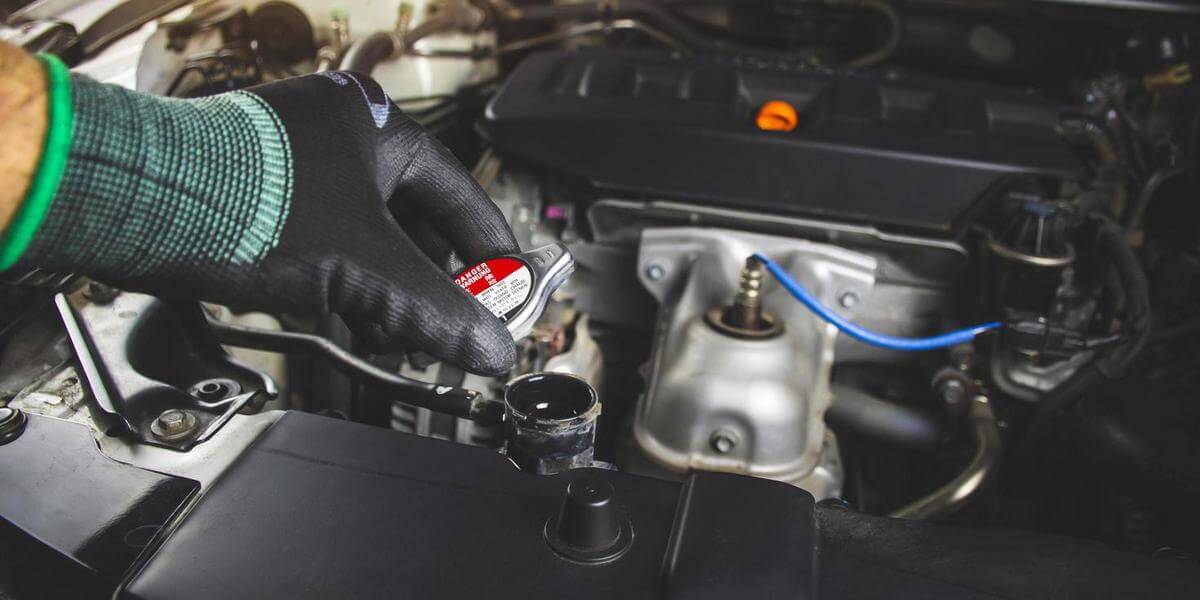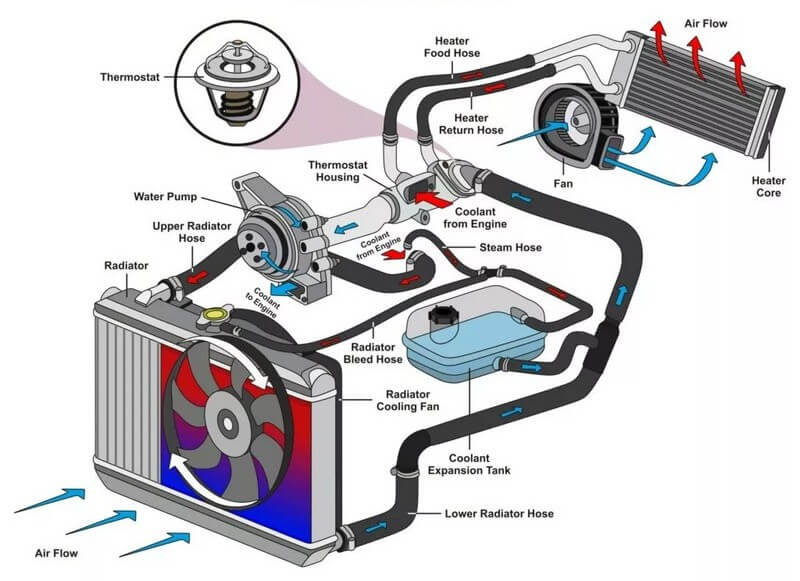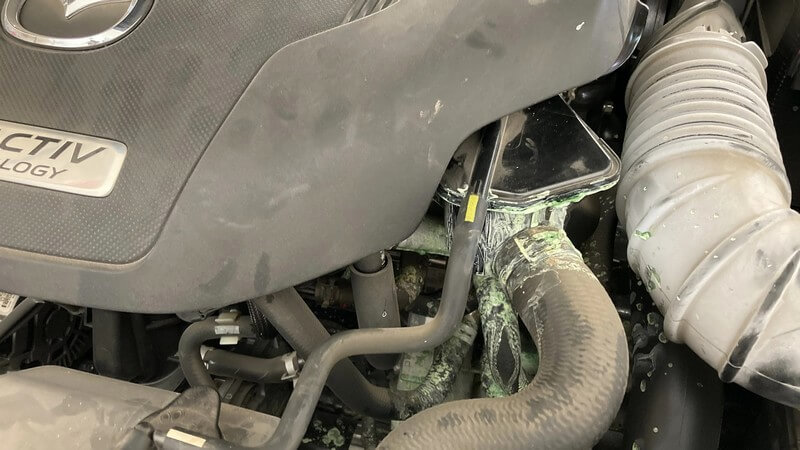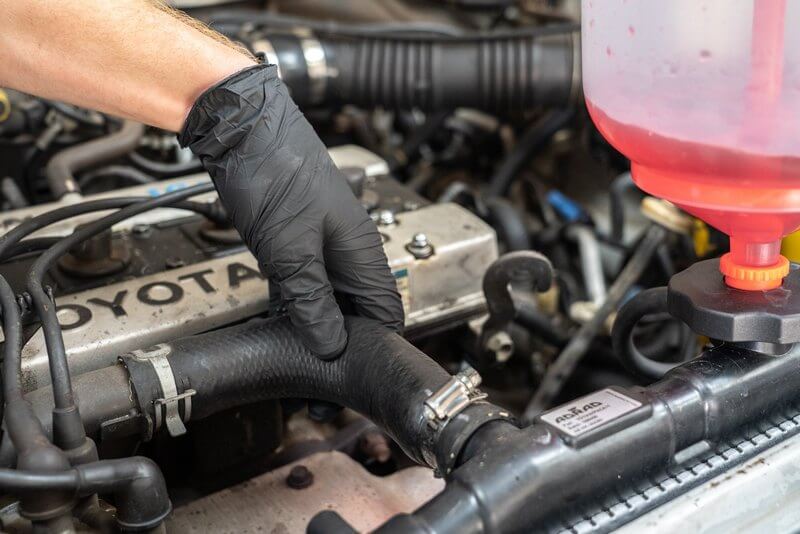
Every year, like clockwork, the start of winter and summer brings a wave of drivers into the shop with cooling system issues. It’s no surprise—temperature extremes can put a serious strain on your engine’s cooling system. Whether it’s battling the heat in summer or guarding against freezing in winter, this system works overtime to keep your engine at the right temperature. And of course, when something does go wrong, it means costly breakdowns, towing fees, and time spent waiting on repairs instead of getting where you need to go.
The good news? A bit of seasonal maintenance can save you the hassle (and expense) of unexpected breakdowns. In this guide, we’ll cover everything you need to know to keep your car’s cooling system in top shape year-round. From choosing the right coolant mix to spotting common issues, these practical tips will help you stay ahead of the game, so you’re not stuck dealing with a steaming hood on a hot day—or worse, a frozen radiator in the middle of winter.
So, let’s dive into the essentials of cooling system care. With these straightforward steps, you’ll be ready to handle any temperature swing, keep your car running smoothly, and hopefully avoid an emergency trip to the mechanic.
Understanding Your Cooling System
Your car’s engine generates a lot of heat, and without an efficient way to manage it, you’d be dealing with overheating, breakdowns, and expensive repairs. That’s where your cooling system steps in. Its job is simple: keep the engine at a safe, steady temperature, no matter the conditions.


What is a Cooling System?
The cooling system is made up of several key parts that work together to pull heat away from the engine. Here’s a quick look at its main components and what they do:
- Radiator – The radiator sits at the front of your car and cools the hot coolant coming from the engine. Once the coolant cools down here, it cycles back to absorb more engine heat.
- Coolant (Antifreeze) – Coolant is the fluid that circulates heat away from the engine. It’s a mix of water and chemicals, usually ethylene or propylene glycol, designed to handle extreme heat and cold. More on coolant types in a bit.
- Water Pump – The water pump keeps the coolant moving through the system, pushing it from the engine to the radiator and back, so heat can be absorbed and released efficiently.
- Thermostat – Acting like a gatekeeper, the thermostat regulates when coolant can flow into the radiator. When the engine’s cold, it stays closed, helping it warm up. Once it’s at the right temperature, it opens to allow coolant flow.
- Hoses – These rubber tubes connect all parts of the system, making sure coolant flows smoothly from the engine to the radiator and back. They’re simple but essential.
Together, these parts work in a continuous cycle. The coolant absorbs heat from the engine, flows through the radiator to cool down, and then circulates back to absorb more heat—keeping your engine at an ideal temperature year-round.
Coolant Basics: Types and Functions
Here are the main types or coolant/antifreeze:
- Ethylene Glycol vs. Propylene Glycol – Ethylene glycol is the traditional choice; it’s effective but toxic. Propylene glycol is safer and eco-friendlier, but slightly more expensive. Both do the job, so check your manual to see which one your car needs.
- Long-Life vs. Standard Coolant – Long-life coolants last up to five years between changes, while standard coolants need replacing every two to three years. Check your car’s requirements, as the wrong type can impact performance and efficiency.
- Coolant Colors – Coolants come in different colors—green, orange, yellow, pink. These colors often reflect different formulations. For instance, green is typically traditional (inorganic additives), while orange often signals a long-life formula (organic acids). Stick with what’s already in your system unless you’re doing a full flush, as different types don’t always mix well.
Coolant does more than regulate temperature. It also prevents corrosion inside the engine and cooling system. Modern coolants contain additives to protect metal parts from rust and buildup, keeping the flow steady and efficient. Plus, coolant lubricates parts like the water pump to keep everything running smoothly. Whether it's summer's heat or winter's chill, understanding your coolant options helps you make the best choice for your car.
Why Seasonal Changes Affect Your Cooling System
As temperatures swing from hot to cold, your cooling system takes on new challenges. Different weather impacts coolant performance, how quickly it breaks down, and even its physical state.
Impact of Temperature on Coolant and Engine Performance
Temperature changes affect your cooling system in two main ways: altering how coolant behaves and increasing engine strain.
Hot Weather
High temperatures mean higher demands on your cooling system. Your engine naturally generates heat, and the cooling system has to work harder on hot days. Without enough coolant or with old coolant, your engine can quickly overheat, risking serious damage to gaskets or engine parts.
- Evaporation Risks: In the heat, coolant evaporates faster, especially if there’s a small leak. This is why topping up coolant is key during summer.
- Increased Pressure on Components: Hot weather increases the pressure in hoses, seals, and the radiator, making them wear out faster or crack.
Cold Weather
Low temperatures introduce their own set of issues. Coolant can freeze if not properly mixed, potentially blocking coolant flow or damaging parts like the radiator or engine block.
- Thicker Coolant: Coolant can thicken in cold weather, especially if it contains too much water, reducing its ability to circulate and absorb heat.
- Strain on Thermostat and Engine: When it’s cold, the thermostat works harder to help the engine reach its ideal temperature. Cold coolant slows this process, reducing fuel efficiency and adding strain.


Common Cooling System Issues by Season
To spot seasonal issues, here’s a quick overview:
|
Summer Issues |
Winter Issues |
|
Overheating: High demand on cooling system, especially if coolant is low or old. |
Freezing Coolant: Improper coolant mixture can freeze and block flow, risking engine damage. |
|
Coolant Evaporation: Heat speeds up coolant evaporation, so check levels often. |
Cold Start Wear and Tear: Engine and thermostat work harder in cold starts, increasing wear. |
|
Leaks: Heat puts strain on hoses and seals, making leaks more likely. |
Cracks and Expansion Damage: Water in the system can freeze and expand, cracking hoses or the radiator. |
Preparing Your Cooling System for Cold Weather
Winter puts a unique strain on your cooling system, so prepping it before temperatures drop can prevent potential breakdowns and costly repairs. Here’s a step-by-step guide to getting your cooling system winter-ready.
Check Coolant Levels and Quality
Start by inspecting coolant levels and condition and keep in mind the following:
- Coolant Level: With the engine cool, locate the coolant reservoir (usually a plastic container near the radiator) and check if the coolant is within the recommended range. If it’s low, top it off with the correct type for your vehicle.
- Coolant Quality: Over time, coolant can break down. If it looks dark, rusty, or sludgy, it’s time for a flush and refill.
- Freeze Protection: Use a coolant tester to check how low the temperature can drop before the coolant freezes. Most coolants, when mixed correctly, offer protection down to around -34°F.
Adjust Coolant Ratio: Water vs. Coolant
Coolant works best when mixed with water in the right ratio. For most vehicles, a 50/50 coolant-to-water mix is ideal, protecting against both freezing and overheating. In very cold areas, you may want a 60/40 mix (coolant to water) for extra freeze protection. Avoid using plain water, as it lacks the antifreeze properties necessary for winter driving.
If you’re unsure about the ratio, consult your vehicle's manual or consider using pre-mixed coolant, which comes ready to pour.
Winter-Ready Coolant: What to Use
Choosing the right coolant can make a big difference in winter. Some coolants are specially formulated to prevent freezing in extreme cold. Make sure to use one rated for your area’s lowest temperatures. You can also add an antifreeze additive in particularly harsh climates for extra protection; ensure it’s compatible with your current coolant, as some additives can disrupt the mix.
If you drive an older car, check the manual or consult a mechanic about specific coolant requirements. Some engines need coolants with added silicates to prevent rust.
Inspect Key Cooling System Components
Winter readiness isn’t just about coolant. Your cooling system’s components—hoses, radiator, thermostat, water pump, and pressure cap—all need to be in good shape. Here’s a checklist:
- Hoses: Look for cracks, bulges, or weak spots, as hoses harden over time and may crack in the cold. Replace any that show signs of wear or leaks.
- Radiator: Check for corrosion, leaks, or blockages. Clear away any debris like leaves or dirt to ensure proper airflow.
- Thermostat: The thermostat helps the engine warm up. If your engine seems to run cold or takes a long time to reach temperature, the thermostat may need replacing.
- Water Pump: The water pump keeps coolant circulating. If you notice leaks or hear unusual noises, have a mechanic inspect it, as a failing water pump can lead to overheating.
- Pressure Cap: A worn or damaged radiator cap can cause coolant to leak or boil over. Ensure it seals properly and replace it if necessary.
Always remember, getting your cooling system ready for winter doesn’t take long but can make all the difference in how your car performs.


Cooling System Maintenance Tips Year-Round
While seasonal checks are essential, regular, year-round maintenance keeps your cooling system in top condition, extends your engine’s life, and helps you avoid costly repairs. Here are the key maintenance steps to keep your cooling system running smoothly in every season.
Flush and Replace Coolant Regularly
Coolant gradually loses its effectiveness, so flushing and replacing it on schedule is essential. For most cars, a coolant flush is recommended every 2-5 years or every 30,000-50,000 miles—check your owner’s manual for specifics.
If you’re comfortable handling it, a DIY flush is easy. Here’s a quick step-by-step guide:
- Ensure the engine is cool, then remove the radiator cap.
- Open the drain plug at the bottom of the radiator and drain old coolant completely.
- Fill with flush solution or plain water, run the engine briefly, then drain again.
- Refill with the correct coolant-water mix based on your vehicle’s specifications.
Regular flushing clears out rust, debris, and sludge, all of which can clog the system and cause overheating. A clean cooling system keeps your engine running at a steady temperature, preventing wear and serious damage.
Routine Inspections and Tune-Ups
Regular inspections on the following can help catch minor issues before they become major problems.
- Monthly Coolant Check: Coolant can evaporate or leak over time. Each month, check the coolant level in the reservoir and top up if needed.
- Hose Inspections: Seasonal changes can wear hoses over time. Check hoses for cracks, leaks, or weak spots, especially where they connect to the radiator, engine, or water pump. Replace any worn hoses to prevent unexpected breakdowns.
- Radiator Fins and Cap: Ensure the radiator cap seals correctly to avoid coolant loss. Inspect radiator fins for dirt, debris, or bending, as these can block airflow. Clean fins gently if needed.
- Watch the Temperature Gauge: If your vehicle’s temperature gauge runs high or fluctuates, it may signal a cooling issue. This can indicate low coolant, a failing thermostat, or a worn water pump—get the system checked if you notice these signs.
Upgrade Cooling System Components
For older vehicles or extreme climates, upgrading a few cooling system components can make a difference. An upgraded radiator can handle more demand, especially in high-performance or older cars.
You can also use a more reliable thermostat that will keep your engine at the right temperature even in extreme weather. Additionally, silicone hoses and a high-performance water pump improve coolant flow, keeping the engine stable.
Protecting the System in Extreme Conditions
Extreme temperatures can push your cooling system to its limits. Here’s how to protect it:
|
For Summer |
For Winter |
|
Coolant Top-Off: Keep coolant levels topped off before long summer drives. |
Freeze Protection: Check coolant’s freeze protection with a tester. |
|
Clear Blockages: Dust and dirt can block radiator airflow; clean the fins as needed. |
Avoid Pure Water: Always use a proper coolant mix in winter to prevent freezing. |
|
Check AC: Running the AC adds strain to the cooling system, so make sure it’s ready. |
Warm Up Engine: Give the engine a few minutes to warm up in winter to keep coolant flowing smoothly. |
With consistent year-round care, your cooling system will stay efficient, helping you avoid problems and extend your engine’s life.
Frequently Asked Questions (FAQ)
How often should I change my coolant?
Most manufacturers recommend a coolant change every 2 to 5 years or every 30,000 to 50,000 miles. Specific intervals vary by coolant type and vehicle make, so refer to your owner’s manual for exact guidance.
Can I use water instead of coolant in my car’s radiator?
Using plain water alone isn’t recommended, especially in extreme temperatures. Unlike coolant, water doesn’t offer anti-corrosion or antifreeze protection, making your engine more prone to freezing in winter or overheating in summer. A 50/50 mix of coolant and water is optimal for year-round performance.
What happens if my coolant freezes in winter?
If coolant freezes, it can block flow through the system, leading to engine overheating. In severe cases, frozen coolant may expand and crack parts of the engine or radiator. To prevent this, ensure your coolant mix has adequate freeze protection.
How can I tell if my coolant needs replacing?
Signs that your coolant needs replacing include a dark or rusty color, sludge buildup, or a strong odor. Check the coolant’s color and clarity regularly, and follow your vehicle’s maintenance schedule for flushing and replacement.
Can I mix different types or colors of coolant?
It’s best not to mix different types or colors of coolant. Mixing incompatible coolants can reduce effectiveness, increase corrosion, and damage your system. Stick with the same coolant type and color in your vehicle, or fully flush the system if you need to switch types.
What’s the difference between coolant and antifreeze?
Coolant is a blend of water and antifreeze (usually ethylene or propylene glycol). The antifreeze component lowers the freezing point and raises the boiling point, making coolant effective across a wide temperature range.
What should I do if my car overheats during winter?
If your car overheats in winter, safely pull over, turn off the engine, and let it cool completely before checking under the hood. Avoid opening the radiator cap while it’s hot, as hot coolant can cause burns. Once the engine is cool, check the coolant levels—cold weather can cause low coolant levels to drop even further. Top up the coolant if needed, and consider using a winter-ready coolant mix. Finally, have your cooling system inspected by a professional to identify any underlying issues, such as a faulty thermostat or frozen coolant.
Keeping Your Engine Cool and Reliable in Every Season
Wrapping up, keeping your cooling system in good shape isn’t rocket science, but it’ll save you a lot of headaches down the line. A few seasonal checks, a little top-off here, a flush there, and you’re good to go. I've seen too many folks end up in the shop with busted radiators and blown hoses, all because a quick coolant check got skipped. It doesn’t take much, but it’ll keep you from having to pull over with steam pouring out of the hood on a scorching summer day—or worse, dealing with a frozen engine in the dead of winter.
So, give your cooling system the attention it deserves. It’s one of those little efforts that go a long way, and your engine—and your wallet—will be grateful. With these tips, you’re ready to roll, no matter what the weather’s doing.
